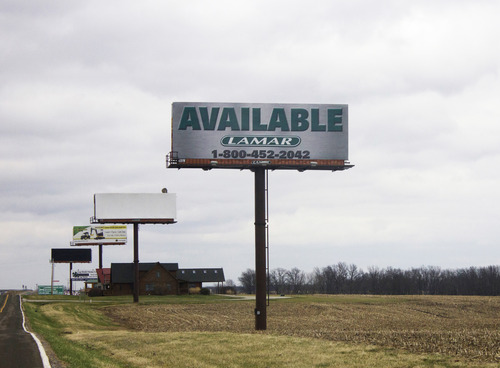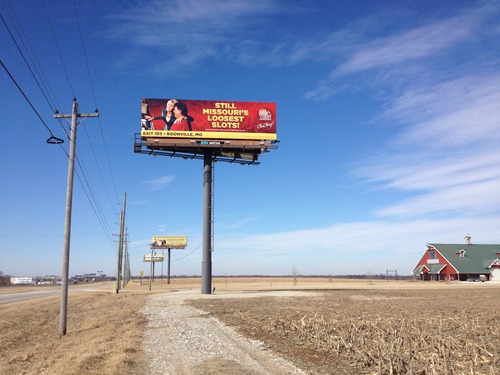
Like the motels and fast-food joints along America’s interstate system, billboards are a ubiquitous roadside feature, a revealing (if archaic) format that refuses to disappear in a digital age. In Missouri, where there is a billboard surplus, these low-budget advertisements can seem like a back-and-forth shouting match in the culture wars, with their commentaries on sex, gambling, firearms, unions, and religion.
The “I-70 Sign Show” is a yearlong event launched in April that engages the Missouri landscape by exhibiting art on an interstate billboard near Columbia, halfway between St. Louis and Kansas City. Six artists are on the main board for two months; then their work rotates to an available board elsewhere on the interstate for another two months, a different location each time. I talked with “Sign Show” organizer Anne Thompson, an artist and writer living in Columbia, about her curatorial agenda.
—Joe Marianek

I. THE BILLBOARDS ARE THE SCENERY
THE BELIEVER: How did Missouri become a billboard capital of the U.S.?
ANNE THOMPSON: It goes back to the Kennedy Administration, when the interstate was new. There were federal subsidies to regulate signage, and Missouri turned those down. Since then—and I’m really simplifying—there’s been this contest between highway-beautification efforts and a powerful ad-industry lobby with money and political clout. About 15 years ago, when it looked like a regulation law might pass, billboard companies went on a construction binge because existing signs would be grandfathered in. Going by state transportation data, which isn’t that current, Missouri has at least 15,000 billboards, which—allowing for states with no billboards (like Maine) and states with lots (like Florida)—winds up being roughly five times the national average.
BLVR: The result of this history is a surplus, which means affordable space and a message blitz—porn, abortion, casinos, fast food, traffic-court lawyers, Christianity, fireworks…
AT: Totally, all that and more. And the situation is especially evident along I-70, the cross-country artery that bisects the state. The land is relatively flat and there’s not much there except farms and truck stops. The billboards ARE the scenery. So the “Sign Show” takes the perspective of a 1970s-era land-art project, something that addresses a given condition in a neutral way and has a site-specific integrity—it’s not arbitrary, like putting art on a billboard to pretty-up a construction site, or generalized, like anti-capitalist campaigns to confront big business or expose the mendacity of advertising.
BLVR: Was your objective to subvert the “real” billboards for shock value or was it more to force a conversation with the unsuspecting masses on the road?
AT: Subversion is definitely a goal, though not for “shock” value. To try to out-shock some of the existing billboards would mean selecting work that would most likely...
You have reached your article limit
Sign up for a digital subscription and continue reading all new issues, plus our entire archives, for just $1.50/month.
Already a subscriber? Sign in




